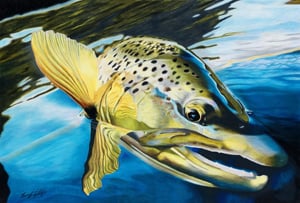Fly Fishing Jazz: Seat Belts, and a Lesson In Humility

“Bryan’s Brown.” Painting by Travis Sylvester
SOME YEARS AGO, Andrew Steketee and I were in the middle phases of writing a book on fly fishing guides (titled Castwork, which would ultimately launch our respective fly fishing writing/editing careers) when we chanced upon Pete Cardinal on the Missouri River in Montana.
Of all the quotes from any of the remarkable guides in that book, the one that haunts me most to this day came from Pete.
He said: “The best fishermen in this world are the ones you have never heard of. There is another level to this whole sport that goes way beyond what most people can imagine. There are a lot of people who get wrapped up in the fly fishing industry, trying to get good enough to be known as an ‘expert.’ There are some who take it a bit further, and eventually try to make a buck or two off it…
“But then there are people out here who go to the final stage. They’re so good, they can teach themselves. They’re so confident, they don’t care if other people think they’re experts. And they care so much about the river and preserving what’s here, that they don’t think of exploiting it for money.”
That’s jazz. The true jazz musician only plays to satisfy his or her soul. Commercial success may or may not happen. I have a strong hunch that Miles Davis, for example, probably didn’t bend any notes from his horn around what he thought would sell more records. From where I sit now, I sometimes wish I could say the same thing about all the stories I write.
Still, I’m happy to know that I can recognize true art and improvisation when I find it. Such an episode happened a few days ago, when I went to Madison, Wisconsin, to be the “featured speaker” at the Southern Wisconsin Trout Unlimited “Ice Breaker” event.
Within minutes of walking through the door, and before I set out to make a practice run with my slideshow, I stopped in the fly tiers room, and was introduced to a reserved, gracious gentleman named John Gribb.
Now you might not have heard of John, but he has a strong following among the devotees to Wisconsin’s “Driftless” region for having developed his own brand of deadly dry flies that trick some of the most wary trout in the nation.
He slices foam, and he bends his hooks (Tiemco or Mustads only) just so, to create patterns and profiles I hadn’t imagined. The kicker: He showed me how to tie stand-up wings that never wilt, by using discarded seat belts from junkyard cars. He says belts from 60s and 70s models are the best. Clip them exactly, add some waterproofing treatment and when you pull the fibers apart, you’re looking at mayfly wings that shimmer perfectly, and can be shaped to fit any imitation one might imagine.
I asked him how in the heck he figured out that seat belts can make ideal mayfly wings on flies tied for trout fishing. And he answered: “My dog ate a seat belt in the back seat one day, and I was angry for awhile, and then I looked closer, and realized that I had seen something that I could use.”
He walked me through his whole deal, and handed me a few tied bugs, as well as a few squares of seat belt fabric to set me on my way.
That’s innovation. That’s improvisation.
I’m not sure I can pull it off like John does, but I’m going to try.
As I ambled toward the podium, I thought to myself: “Man, just when you think your bag of tricks is really deep (or at least deep enough to keep the audience’s attention), somebody shows up who rocks your mind, and proves that no matter where you’ve been and what you’ve seen, you’re still only five steps down a mile-long trail.”
And for that, I was deeply grateful.











